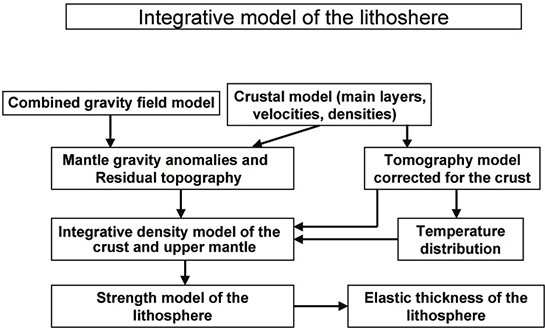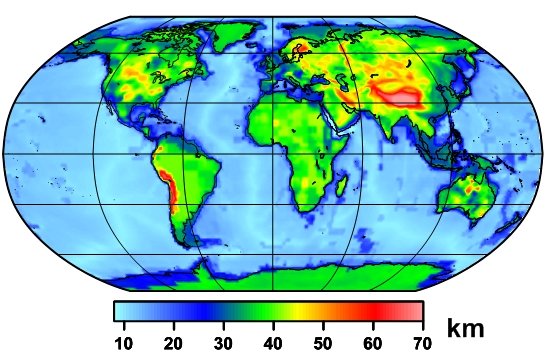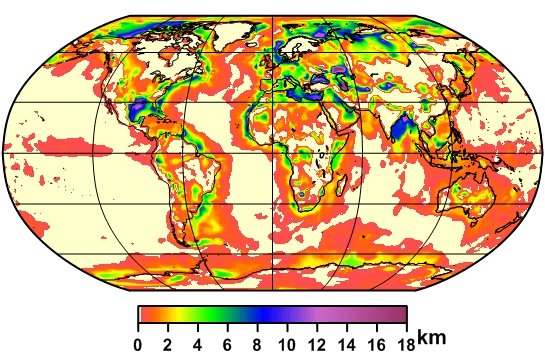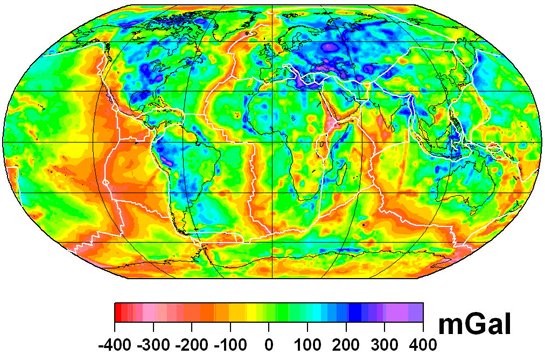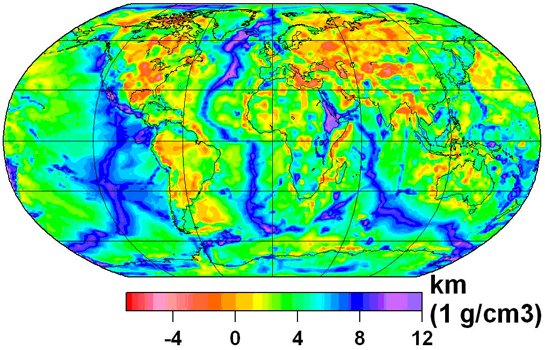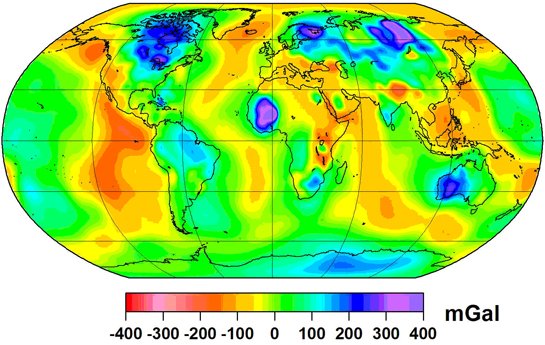Integrative gravity and isostatic models of the lithosphere and upper mantle
The aim of this subtopic is to construct a comprehensive global model of the crust and upper mantle and to determine the impact of the lithosphere on the observed gravity field. To solve this problem we use a joint analysis of the gravity field/geoid with seismic P-, and S-velocities, surface topography, heat flow and other geophysical and mineral-physics data.
We use a joint analysis of the gravity field/geoid with seismic (P-, S-velocities), surface topography, heat flow and other geophysical and mineral-physics data, which are integrated into a comprehensive global model of the crust and upper mantle. Density anomalies resulted from temperature and compositional variations represent one of the main driving forces of the tectonic processes. Rheological properties of the lithosphere are other principal constraints, which are required for quantitative modelling of the dynamic processes. Therefore, the results obtained by the integration of these parameters can be used to forecast the future behavior of entire geological systems, as well as of specific subsurface geological features. The aim of this research is to be reached through several steps, as displayed in Fig.1 and some results are demonstrated below. The thermal and rheological models are demonstrated in the next part.
The Earth crust is the most heterogeneous layer, it completely masks the effects of deep seated heterogeneities, especially in the observed gravity field. Crustal models primarily based on existing reflection and refraction seismic profiles are used to reduce these effects ‘before hand’. In cooperation with the U.S. Geological Survey (Walter D. Mooney) we develop a new global high resolution (1°x1°) crustal model. One example is the Moho map, which is principally improved in several regions: North America, Eurasia and Australia (e.g., Tesauro et al., 2008; Mooney and Kaban, 2010; Stolk et al., 2012). Other regions are covered by the CRUST2.0 model (Bassin et al., 2000). Other parameters of the crust have also been revised using these new datasets. For example, the global map of the sedimentary thickness includes new compilations for the continents (Tesauro et al., 2008; Mooney and Kaban, 2010) and for the oceans (NOAA, 2010).
In the next stage we have computed the gravity field induced by the crustal density inhomogeneities and removed it from the observed gravity field and from the observed topography. The residual "mantle" anomalies display mantle density heterogeneity. All active tectonic centers and main plate boundaries are also reflected in this map.
The next problem is to discriminate between the effects of thermal and compositional variations, therefore to locate temperature and chemical variations in the mantle. This goal can be achieved via a joint analysis of the mantle anomalies with seismic, geothermal and mineral physics data. As a result we get these two maps, which show the gravity effect of thermal and compositional anomalies in the upper mantle.
Starting with global Earth's gravity, topography and crustal models, isostatic gravity anomalies and geoid undulations have been determined. The initial crust and upper mantle density structure has been corrected in a least squares adjustment using gravity and seismic tomography data. The calculated residual geoid undulations more realistically describe the signals from mantle convection and deep density inhomogeneities than the observed geoid.
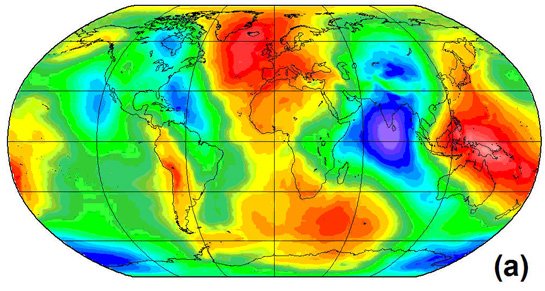
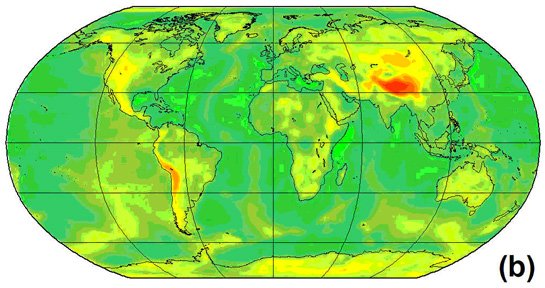
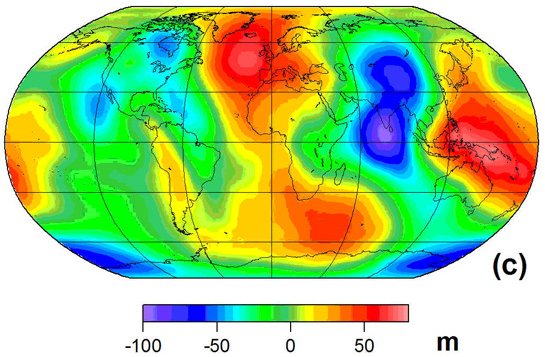
Literatur
- Kaban, M.K., Schwintzer, P.; Tikhotsky, S.A. (1999): Global isostatic residual geoid and isostatic gravity anomalies.: Geophys. J. Int., 136, 519-536.
- Kaban, M.K.; Schwintzer, P. (2001): Oceanic upper mantle structure from experimental scaling of VS and density at different depths. Geophys. J. Int. 147, 199–214.
- Kaban, M.K.; Schwintzer, P.; Reigber, C. (2004): Signaturen des Erdmantels im Schwerefeld der Erde, Zweijahresbericht Geoforschungszentrum Potsdam 2002/2003, Geoforschungszentrum, 119-125.
- Kaban, M.K.; Schwintzer, P.; Artemieva, I.M.; Mooney, W.D., (2003): Density of the continental roots: compositional and thermal contributions. Earth and Planetary Science Letters, 209, 53-69.
- Kaban, M.K.; Schwintzer, P.; Reigber, C., (2004): A new isostatic model of the lithosphere and gravity field, Journal of Geodesy 78, 368-385.
- Kaban, M.K.; Schwintzer, P.; Reigber, C. (2005): Dynamic topography as reflected in the global gravity field. - In: Reigber, C., Lühr, H., Schwintzer, P., Wickert, J. (Eds.), Earth observation with CHAMP : Results from Three Years in Orbit, Springer, 199-204.
- Kaban, M.K.; Tesauro, M.; Cloetingh, S. (2010): An integrated gravity model for Europe's crust and upper mantle. Earth Plan. Sci. Let. doi:10.1016/j.epsl.2010.04.041.
- Mooney, W.D; Kaban, M.K., (2010): The North American Upper Mantle: Density, Composition, and Evolution, J. Geophys. Res., 115, B12424, doi: 10.1029/2010JB000866.
- Tesauro, M.; Kaban, M.K.; Cloetingh, S.A.P.L. (2012): Global strength and elastic thickness of the lithosphere, Glob. Planet. Change (2012), doi:10.1016/j.gloplacha.2011.12.003.

